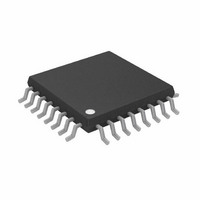AD5762RCSUZ Analog Devices Inc, AD5762RCSUZ Datasheet - Page 21

AD5762RCSUZ
Manufacturer Part Number
AD5762RCSUZ
Description
IC DAC DUAL 16BIT 1LSB 32-TQFP
Manufacturer
Analog Devices Inc
Datasheet
1.AD5762RCSUZ.pdf
(32 pages)
Specifications of AD5762RCSUZ
Data Interface
Serial
Settling Time
8µs
Number Of Bits
16
Number Of Converters
2
Voltage Supply Source
Analog and Digital, Dual ±
Power Dissipation (max)
180mW
Operating Temperature
-40°C ~ 85°C
Mounting Type
Surface Mount
Package / Case
32-TQFP, 32-VQFP
Resolution (bits)
16bit
Sampling Rate
84.6MSPS
Input Channel Type
Serial
Supply Voltage Range - Digital
2.7V To 5.25V
Supply Current
4.25mA
Digital Ic Case Style
QFP
Lead Free Status / RoHS Status
Lead free / RoHS Compliant
Available stocks
Company
Part Number
Manufacturer
Quantity
Price
Company:
Part Number:
AD5762RCSUZ
Manufacturer:
Analog Devices Inc
Quantity:
10 000
Company:
Part Number:
AD5762RCSUZ-REEL7
Manufacturer:
Analog Devices Inc
Quantity:
10 000
THEORY OF OPERATION
The AD5762R is a dual, 16-bit, serial input, bipolar voltage output
DAC that operates from supply voltages of ±11.4 V to ±16.5 V and
has a buffered output voltage of up to ±10.5263 V. Data is written to
the AD5762R in a 24-bit word format via a 3-wire serial interface.
The AD5762R also offers an SDO pin that is available for daisy
chaining or readback.
The AD5762R incorporates a power-on reset circuit that ensures
that the DAC registers are loaded with 0x0000 on power-up.
The AD5762R features a digital I/O port that can be program-
med via the serial interface, an analog die temperature sensor,
on-chip 10 ppm/°C voltage reference, on-chip reference buffers,
and per channel digital gain and offset registers.
DAC ARCHITECTURE
The DAC architecture of the AD5762R consists of a 16-bit
current mode segmented R-2R DAC. The simplified circuit
diagram for the DAC section is shown in Figure 39.
V
The four MSBs of the 16-bit data-word are decoded to drive
15 switches, E1 to E15. Each of these switches connects one of
the 15 matched resistors to either AGNDx or I
12 bits of the data-word drive Switch S0 to Switch S11 of the
12-bit R-2R ladder network.
REFERENCE BUFFERS
The AD5762R can operate with either an external or an internal
reference. The reference inputs (REFA and REFB) have an input
range up to 7 V. This input voltage is then used to provide a buf-
fered positive and negative reference for the DAC cores. The
positive reference is given by
The negative reference to the DAC cores is given by
These positive and negative reference voltages (along with the
gain register values) define the output ranges of the DACs.
REF
E15
4 MSBs DECODED INTO
+V
−V
15 EQUAL SEGMENTS
2R
REF
REF
E14
= 2 × V
= −2 × V
2R
E1
REFIN
Figure 39. DAC Ladder Structure
2R
REFIN
R
S11
12-BIT, R-2R LADDER
2R
R
S10
2R
R
S0
2R
OUT
2R
AGNDx
. The remaining
I
R/8
OUT
VOUTx
Rev. A | Page 21 of 32
SERIAL INTERFACE
The AD5762R is controlled over a versatile 3-wire serial
interface that operates at clock rates of up to 30 MHz and is
compatible with SPI, QSPI™, MICROWIRE™, and DSP standards.
Input Shift Register
The input shift register is 24 bits wide. Data is loaded into the
device, MSB first, as a 24-bit word under the control of a serial
clock input, SCLK. The input register consists of a read/write
bit, a reserved bit that must be set to 0, three register select bits,
three DAC address bits, and 16 data bits, as shown in Table 9.
The timing diagram for this operation is shown in Figure 2.
Upon power-up, the DAC registers are loaded with zero code
(0x0000), and the outputs are clamped to 0 V via a low impedance
path. The outputs can be updated with the zero code value by
asserting either LDAC or CLR . The corresponding output voltage
depends on the state of the BIN/ 2sCOMP pin. If the BIN/ 2sCOMP
pin is tied to DGND, the data coding is twos complement and
the outputs update to 0 V. If the BIN/ 2sCOMP pin is tied to DV
the data coding is offset binary and the outputs update to negative
full scale. To have the outputs power-up with zero code loaded
to the outputs, the CLR pin should be held low during power-up.
Standalone Operation
The serial interface works with both a continuous and noncon-
tinuous serial clock. A continuous SCLK source can be used only
if SYNC is held low for the correct number of clock cycles. In gated
clock mode, a burst clock containing the exact number of clock
cycles must be used and SYNC must be taken high after the final
clock to latch the data. The first falling edge of SYNC starts the
write cycle. Exactly 24 falling clock edges must be applied to SCLK
before SYNC is brought high again. If SYNC is brought high before
the 24
24 falling SCLK edges are applied before SYNC is brought high,
the input data is also invalid. The input register addressed is
updated on the rising edge of SYNC . For another serial transfer
to take place, SYNC must be brought low again. After the end of
the serial data transfer, data is automatically transferred from the
input shift register to the addressed register.
When the data has been transferred into the chosen register of
the addressed DAC, all DAC registers and outputs can be updated
by taking LDAC low.
th
falling SCLK edge, the data written is invalid. If more than
AD5762R
CC
,













